
Neck Sharpies: Shoop, Jean-Mary, and Zone Blitzing

Michigan added a couple of defensive assistants last week to replace rising stars Chris Partridge and Anthony Campanile. Both losses grate for different reasons—Partridge was due to move up but chose easily the least respectable program in the Power 5, Campanile took a lateral move into the NFL after Michigan fought off other suitors, possibly botching their own chances to retain him in the process. On the recruiting front, neither is replaceable, especially Partridge, who was the first assistant at Michigan since Cam Cameron to have sustained success recruiting the Deep South.
Some of that ground will be made up for with Brian Jean-Mary, a scion of Apopka who's been recruiting the Confederacy since the first time I swiped my M-Card at the Union—for example I noted while doing his hello post that 9 of Louisville's top 10 recruits in 2013 were Floridians. I suspect, however, that there was another goal in mind with Harbaugh's recent hires. I can't say Harbaugh hired Bob Shoop and Brian Jean-Mary because those were the two most experienced former defensive coordinators on the market in the kind of defense Michigan was running a lot last year. But if the goal was to find guys who know more about zone blitzing than anybody not in a job, Shoop and Jean-Mary were #1 and #2. And given the types of players they've been recruiting, and the types of weaknesses on the depth chart, I think it's fair bet that Harbaugh and Don Brown are at least a little zone blitz curious.
As are we.
The Path of Shoop/The Don Brown Connection
Though best known as James Franklin's DC at Vanderbilt and Penn State, most of Shoop's coaching career has been either as a secondary coach or defensive coordinator in the same New England coaching circle as Don Brown. The 53-year-old Northeasterner played for Yale in the late 1980s, was the head coach of Columbia for three years, and spent a year coaching defensive backs under Don Brown at UMass in 2006.
From there Shoop moved on to the defensive coordinator job at William & Mary, where he won the FCS version of the Broyles Award, whence Franklin hired him as the new Vanderbilt DC and safeties coach. In 2016 Bob surprisingly left Penn State to join Butch Jones at Tennessee, which means yes, Shoop had Brady Hoke as his defensive line coach and was then Hoke's defensive coordinator for half a season after Jones was fired. Shoop was also key in recruiting Joe Moorhead to join Penn State's staff in 2016; Bob was most recently Moorhead's defensive coordinator at Mississippi State. I posted the path in full on the message board this week.
Shoop left Penn State after two seasons, and not on good terms—the university sued him for for just under $1 million for breach of contract for departing for Tennessee in January 2016. Shoop was countersuing under the claim that Franklin had already all but fired him at that point (their linebackers coach and current PSU DC Brent Pry had already been elevated to "co-coordinator"). The countersuit also claims Shoop was subjected to a "hostile, negative work environment" at Penn State. The suits were ultimately settled in February 2018.
Shoop was also the guy who got Gattis on James Franklin's staff. Bob's younger brother John met Gattis when the latter was finishing his pro career with the Bears, shortly before the former took the offensive coordinator job at North Carolina. John Shoop gave Gattis his introduction to coaching offense at UNC, then lobbied his brother to snag the up-and-coming assistant when Franklin had an opening for receivers coach at Vanderbilt.
[After THE JUMP: Examining the defenses Shoop and Jean-Mary came from]
Zone Blitzing Primer
Announcers tend to call anything with a dropping defensive lineman a zone blitz, or call any blitz a zone blitz even if there's man coverage behind it. For the sake of having any definition let's just stick to the idea of bringing a four- or five-man pressure while still playing a sound (read: six or more zone defenders) zone defense behind hit. The appeal of zone blitzes is not in crazy pressures but in disguising pressure while staying in a relatively safe coverage.
While most trace zone blitzing defenses to the 1990s Steelers, I think you have to go back another 20 years, when quick passing games started shredding the 5-2 defenses everybody played. These defenses fell into two camps: those who wouldn't give up the mano-a-mano nature of the front-line battle (Oklahoma), and those who wouldn't give up having tackles over tackles to take away the prime running lanes, assigning gap responsibilities instead of head-to-head matchups (Eagle). The latter developed thicker ends, kept moving the nose away from the line of scrimmage, and ultimately gave rise to the 4-3 defense. I have a video on this if you want the full story:
Anyway the offenses had a response to this too: Quick passing. If you're removing a linebacker from the box and having the remaining linebackers playing the run aggressively to compensate, guess what those linebackers aren't doing anymore? Protecting the short passing game in the hole and the flats. This movement that would define post-War football began with the pop passes, screens, and misdirection of Fritz Crisler's Mad Magicians at the end of the 1940s. But it really started wrecking in the symphony of route combinations, timing, and footwork of the West Coast offense in the 1980s.
One of these offensive innovations was the hot route. Especially in the West Coast offense, the quarterback might have a progression to beat any man or zone provided he's given enough time to get through it. Blitzes were crushing that math until offensive coordinators began to give their passers a place to put the ball immediately if they see a blitz. If the weakside ILB is coming, there'd be a slant behind him, or an angle route by the running back, or a tight end curl.
Defenses were damned if they did or didn't, but didn't want to give up blitzing inside linebackers. So somebody else had to drop into that space. And that was how we got zone blitzing.
The guy credited for doing it first—or more accurately, the first to base his defense around this strategy—was Dick LeBeau, while running his 3-4 defense in Pittsburgh in the early 1990s. While the passing games necessitated the transitions from 5-2 to 3-4 or 4-3 personnel, the structure of those defenses remained largely unchanged—LeBeau himself called his defense the Oklahoma until the end of the century. Dropping edge defenders into zones had been going on since the early 1970s. LeBeau's innovation was to constantly mix pressures and where they came from to take away easy passing games.
It was a thought process kind of born out of necessity. It was basically an outcropping of the run-and-shoot [offense] that was becoming pretty prevalent in the league back then. We were in the same division as Houston, and they were tremendous at it with Moon and Co. Then the West Coast offense was spreading throughout the league. Those were all quick-rhythm, get-the-ball-out-of-your-hands-and-cut-up-the-defense types of passing games. We were just looking for ways to get pressure without exposing our defensive backs to have to cover the whole field all of the time.
As offenses got more comfortable with passes to the areas abandoned by the cornerbacks, those ends took on more coverage duties, becoming linebackers in fact. And with so many linebackers—committed, full-time linebackers—now on the field, defensive coordinators could bring heat from all over the place while still dropping six defenders into coverage, all from the same pre-snap look.
There is virtually no end to the mixing and matching, especially once you factor in 4-man rushes, 3-man rushes, blitzes from safeties and cornerbacks, and different types of coverages. I'll stop it there because Smart Football's Chris Brown does:
I define blitzes as defenses with five or more rushers (thus a defense that rushes four and plays zone is not really a zone blitz), and, because it is nigh impossible to play competent zone coverage with fewer than about six defenders, zone blitzes, properly defined, only feature five pass rushers. By contrast, a man-to-man blitz can have up to seven or eight guys rushing, and, again, because of simple arithmetic, the defense can always rush one more guy than the offense can block with, because the defense has a counterpart to the ball carrier.
The 4-3 defenses quickly caught on to this too, dropping an end into a zone abandoned by the blitzer to accomplish the same thing the 3-4 defenses were doing with their OLB/ILB swaps. Today, everybody is a zone blitzer. It's just that some coaches are more into it than others, and do it in different ways.
Bob's Blitzes
In our 2014 Penn State preview, former Black Shoe Diaries X's & O's writer Ben Scaff went into Bob Shoop's defenses at Vandy, which were heavy on zone blitzes. While philosophically similar to Brown—Shoop believes in bringing pressure and forcing offenses out of their comfort zones—the way Shoop goes about it is quite different. His base defenses is Quarters, and reminds me a lot of Lloyd Carr's defenses.
They align out of a 4-3 under two-high, with the MLB often cheating to the edge of the box.
While the base is a Cover 2 that rushes four guys, the "strong safety" and "SAM linebacker" feature heavily as guys who are asked to sprint up from depth. Without substantially changing this coverage he'll often have either OLB blitz the edge, or flip to a Cover 3 with that backside safety rolling down like an OLB.
You may recall heavy-hitting safety Marcus Allen and OLB Brandon Bell doing a lot of damage in this defense. Shoop had some great defensive tackles and liked to stopper up the three interior linemen dealing with them, freeing up a linebacker to blitz. The above may be a base, but five-man pressures were the norm, and six-man pressures came often. He liked to bring Bell and a linebacker, often dropping a DL and rolling the safeties into a Cover 3:
The five-man pressure version of this—with the MLB and WLB both dropping into coverage—features just as often, adding a "What's the MIKE doing NOW?" to the quarterback's every-down thought process.
This put a lot of pressure on the safeties, especially when Shoop didn't have the linebackers to execute all of their drops. But Shoop coaches the safeties himself and managed to get a lot of chicken salad out of the guys he inherited at both Vanderbilt and Penn State—guys like Malik Golden (a last-second converted WR), Jonathan Keiser (the guy who whiffed on the great Funchess catch in 2014) and converted cornerbacks Jourdan Lucas and Adrian Amos, before his star recruit Marcus Allen was ready. The latter three are all still in the NFL.
Shoop also likes to fuck around:
Do you really need to hire a guy to come up with this stuff? Well coaching—especially college coaching—is funny in this way. There are a ton of concepts out there that your defensive coordinator surely knows of. But the limited time you have to teach it means every team is limited to a few concepts they can drill to execution, and further limited by how well the coach knows how to get this stuff across, and his sense for when to pull it out.
Don Brown has lots of zone blitzes. He's also one of the most researched and followed coaches in college football, and Ohio State especially has done a good job of scouting what he's good at, how he uses it, and where its weaknesses are. Many in the fanbase have been (misguidedly) calling for Brown's head because of the last two debacles in The Game. Shoop is not only a polished secondary coach who's worked out his drills and how to teach them to young safeties (of which Partridge left us many). He's also been living deep in 4-3 zone blitz world. He's got different ideas than Brown, and knows how to install them and call them. He's also run a mostly Cover 2/Cover 3 defense at every stop.
Brian's Blitzes
Michigan did a lot more of it in 2019 than any other season under Don Brown. Part of that was all the zone they installed. Most of it was because Josh Uche was on the field all the time as a DE/LB hybrid, and one of the things you can do with a guy like that is drop him into coverage:
Had several ask throughout the year why Michigan kept dropping a defensive end into coverage ... Uche was ready to be more than a defensive end probably by the end of 2018. Obviously happened in 2019. He continues to be an interesting hybrid edge prospect with a lot ahead of him. https://t.co/08vquUDWHF
— Nick Baumgardner (@nickbaumgardner) January 23, 2020
Jean-Mary too has been a defensive coordinator, and been involved in Charlie Strong's defensive schemes for a very long time. Strong's name is synonymous with the 3-3-5 defense, a new take on the 3-4 that solved problems the modern spread created by replicating the transition from 5-3 to 5-2: remove a player from the box for a hybrid safety on the tight end's side, stay balanced, and keep the offense off-balance by constantly changing up your fronts.
The 3-3-5 debuted in college football—under Joe Lee Dunn at Memphis and Mississippi State—around the same time Dick LeBeau starting running zone blitzes. Charlie Strong adopted it at South Carolina under Lou Holz, and built his version around Cover 3 pattern-matching (see: Saban's secondary) and zone-blitzes. Moreover, it eschewed the old 3-4 style of two-gapping with big burly linemen, instead stunting dudes and giving everybody a gap and blitzing linebackers for a standard four-man front.
There are different styles of 3-3, and Strong’s was of the attacking variety. On just about every snap, his linemen were instructed to attack a gap — the space between offensive linemen — and get into the backfield to make things generally unpleasant for offenses. This is an important difference between the 3-3-5 and the 3-4. The traditional 3-4 is a two-gap defense, which means that the defensive linemen typically line up “heads up” on the offensive linemen and are responsible for the gaps to either side. This leaves the linebackers free to roam. In the 3-3-5, there are more stunts, and usually at least one linebacker is rushing. This means each player ends up responsible for one specific gap, though the player’s specific responsibility will change from play to play.
When Michigan brought back this personnel group for the Florida game in 2017, it wasn't a conversion to the 3-3-5 lifestyle but an adaptation of 3-3-5 personnel to the 4-2-5 Cover 1 base defense they played the year before. Their plan was to use one linebacker as a quasi-defensive lineman—you just never knew where he was going to insert. Their five-man pressures in that game in particular used Noah Furbush as a kind of fullback for Devin Bush to run behind. Once offenses had it on tape the gimmick no longer worked.
Jean-Mary has been living the 3-3-5 lifestyle, which is all about zone blitzing.
This doesn't feel that different from anything Don Brown ran last year on 3rd and long. If there's a difference it's Texas's nose tackle here got penetration and made the play. I'll keep hammering the DT thing—good ones are important in any scheme. The other difference however is Strong's defenses were typically very sound despite how unconventional they appear at the snap:
They were also able to hold up to the run despite playing gap defense with undersized players, both because their gaps were sound, and because the constant shifting of the lines and different angles of attack kept the offensive line guessing what their job might be on any given play.
And of course they got to the quarterback a lot. Strong and Jean-Mary liked to use what they called the "Psycho" defensive line. I got this gif off of Ian Boyd's intro to Strong's defense for USF fans:
But if you've goofed around much on NCAA Football 2014 you already know this group—it's one defensive lineman and five linebackers, milling about until the snap and then coming in all sorts of configurations. Louisville's best position group at this time were the linebackers, a credit to Jean-Mary as a recruiter and position coach. I don't know the extent to which his expertise on the 3-3-5 is going to become part of Michigan's base defense next year. But I would have to guess, considering how much Michigan's already been dabbling in those waters, and how few playable defensive tackles they seem to have right now, having a top 3-3-5 guy on staff should help.
January 24th, 2020 at 11:28 AM ^
Defense is going to Shoop da Woop?
January 24th, 2020 at 3:57 PM ^
Sometimes meme's need to die.
January 24th, 2020 at 11:35 AM ^
btw, the John Shoop era at Purdue ended in 2015 - not sure if he decided to stay clear of the business after that, if the wreck of the offense he presided over was the problem, or if it was a mix of the two.
January 24th, 2020 at 12:05 PM ^
Enlightening post as always. Thank you Seth.
January 27th, 2020 at 8:19 AM ^
Yes indeed. What this post highlights for me is that while the conventional wisdom on the outside is that Michigan needed to replace Partridge and Campanile with ace recruiters and deemphasize other coaching attributes, Harbaugh and Brown decided they really needed to upgrade their defensive scheme to tackle the problems they've had with Hamler and the OSU passing game. (It appears as a bonus that Jean-Mary is no slouch on the trail.)
Boola boola! Let's hope it works.
January 24th, 2020 at 12:11 PM ^
I feel like JH's hires have been good so I want to give him the benefit of the doubt here. But, he's also lost some important pieces over the years like GMatt, Washington, & Partridge. Maybe at some point we'll strike the balance between coaching & recruiting to get us over this OSU hump.
January 24th, 2020 at 3:56 PM ^
I can see that. However, Partridge wanted the DC role; and Washington had tight ties to OSU. I can't blame the guy for that. Mattison was the one that hurt. Kind of a jerk move. Camp... I don't know. I don't necessarily think going to the NFL is a lateral move if that is where your ambitions lie. But it is weird he isn't listed as being on staff there yet.
January 24th, 2020 at 12:35 PM ^
This is similar to what Harbaugh likes to do with his offense. Throw a bunch of guys that have experience running a offense and have them all provide input into it. First it was Harbaugh, Fisch and Drevno. Now it's Harbaugh, Gattis and Warinner. I'm not sure the current team has the bodies needed to maximize all these coaches specialties before they leave for another job. My hope is that the defense remains a top ten unit; these new coaches provide a recruiting and schematic profile their successors can follow.
January 24th, 2020 at 1:06 PM ^
Great as always. You made a good point about have quite a few good safeties on roster already. I'd say outside of corner and tackle (minimized in a base 3-3-5) we have a ton of good players on defense right now. Operating threory: We have the Jimmies and Joes, now we need the Xs and Os to get over the hump. And Brown can't do it all himself.
For all the nonsense about Partridge to DC, we don't anything about his Xs and Os, only his recruiting chops.
January 24th, 2020 at 1:09 PM ^
For some reason, I'd never thought about the "zone" aspect of zone blitzing - too much listening to bad announcers, I guess. Having the history and the explanations for it really helps to understand it ... as always, great work.
January 24th, 2020 at 1:49 PM ^
How will this work against the "big beefy" Wisconsin style teams? You have to hope stealth and speed beats the big beefy guys to the hole?
January 24th, 2020 at 2:06 PM ^
Good question - I wonder if they’d add a fourth lineman back in. IIRC the problems against UW this year were fitting the run and gap discipline as much as anything. Didn’t help on those goal line downs when we trotted Glasgow in as a psuedo lineman, either
January 24th, 2020 at 1:55 PM ^
Seems like the offensive coaches have done a decent job at surprising osu with their gameplans in the Harbaugh era. Why haven't our defensive coaches been able to do that? Seems like osu has always been one step ahead of Brown.
January 24th, 2020 at 2:17 PM ^
I am not defending the poor performance of our D against OSU the past few years, but the general rule is that all things being equal, the offense starts out with an advantage over the defense (the offense knows where it is going, and the D has to react to what the O does). Now take a look at OSU's offensive roster. It's insanely talented. I would argue that the talent disparity as a whole between the OSU O and Mich D is far greater than the disparity between the OSU D and our O.
Combine the natural advantages that an offense has over a D, then add in the talent gap, and for good measure don't forget that OSU practices to beat us in every single practice and that we are probably one of only a handful of games in which they come out fully weaponized, and that might be the answer to your question.
January 24th, 2020 at 2:36 PM ^
I agree with most of your points, but still feel like Brown needs to do a lot more to surprise their offense with what schemes he brings out for that game. We should be saving defensive looks that we work on all season just for that game.
January 24th, 2020 at 2:52 PM ^
Go blue 80. Another way to say what you said is that OSU offense did a good job surprising UM defense. Why didn’t OSU defense do the same? Poster below nailed...offenses have the advantage
January 24th, 2020 at 3:44 PM ^
It's not tough to surprise a defense when it runs a similar gameplan that it has most of the season.
January 24th, 2020 at 1:55 PM ^
I think Brown can get what he needs by visiting with who he wants based on his stature in the profession.
I think Shoop was hired because Brown is comfortable and respects him as a coach and after Campy left pickings were slim. Good 1 yr deal for both.
Jean seems like Jim making a good strong hire and we will see what happens.
January 24th, 2020 at 2:25 PM ^
Is shoop a one year rental or is he the DB replacement after he retires?
January 24th, 2020 at 2:46 PM ^
Seth, I would love to hear your speculative thoughts on why Don Brown is moving to more 3 DL packages. In particular, do you think this is motivated by what OSU has been doing under Day?
January 24th, 2020 at 2:48 PM ^
I think it's a quite obvious reaction to the fact that Josh Uche on the field was >>>>>>>>>>>> any DT after Carlo Kemp.
But I think playing with it for a season opened Brown's eyes to ways he'd like to make this more of a base defense against non-OSU/Wisconsin/Bama-level spread teams (Purdue, Indiana, etc.) and that means running more zone blitzes instead of making every pressure a live or die with your man coverage prospect.
January 24th, 2020 at 3:50 PM ^
I'm not sure I follow Brown's logic. Aren't we already good enough to stop the Purdue, Indiana's of the world without moving further into 3 down lineman territory? Shouldn't we be moving closer to the types of base defenses that can match up better with the teams we aren't beating? (Maybe this move does that and I'm just uninformed.)
January 24th, 2020 at 6:36 PM ^
I was thinking the same thing.
January 24th, 2020 at 4:51 PM ^
Thanks for the response!
If I may ask a follow up, do you think from a roster balancing perspective, it seems like they've been recruiting for this kind of switch in philosophy?
January 24th, 2020 at 3:34 PM ^
Great stuff. Thank you.
January 24th, 2020 at 4:59 PM ^
"since the first time I swiped my M-Card at the Union"
Gee, thanks for making some of us feel really old. IIRC, I had to show my Michigan ID card when registering for classes listed on green bar paper. Other than that, it was only good for jimmying locks.
Cue the person older than me whose Michigan ID was a clay tablet.
January 24th, 2020 at 5:34 PM ^
Anyone else confused by that weird "13" next to Ohio State in the Zettel pick-six clip?
January 27th, 2020 at 7:56 PM ^
Just dont run any more of that defense where your safety is covering Jerry Jeudy but is 20 yards away at the snap. Thanks in advance
January 28th, 2020 at 11:29 AM ^
Relevant to MGo fans - when Shoop arrived at PSU in 2014 he had 0 returning starts at DT, and only 1 appropriately sized DT on the entire roster. He switched from his favorite Over front to an Under. He stuck the lone DT he had at NT (Austin Johnson). He pulled reserve 260-lb DE Anthony Zettel into 3-tech DT (weakside). And he also pulled his only experienced LB - the undersized, oft-injured OLB Mike Hull - to MLB, where he'd have more protection in the Under.
In making this chicken salad, Shoop improved PSU from 49th (2013) to 2nd (2014) in total defense. Aiden-Hutchinson-sized Zettel got tons o' one-on-one matchups with guards, and registered 17 TFLs. Mike Hull played the entire season, and, free from playside guards in his face, used his speed to clean up mistakes (140+ tackles).
(Shoop also simplified and taught the back end to great effect, playing a lot of 2 or 3 zone, since he had 3 ought-to-play-safety types, and 0 man CBs - but that's less interesting).
In short, Shoop displayed smarts and flexibility in his 2 years at PSU. Probably he's only a 1- or 2-year rental for you, but his more conservative nature may be what Dr. Brown needs.
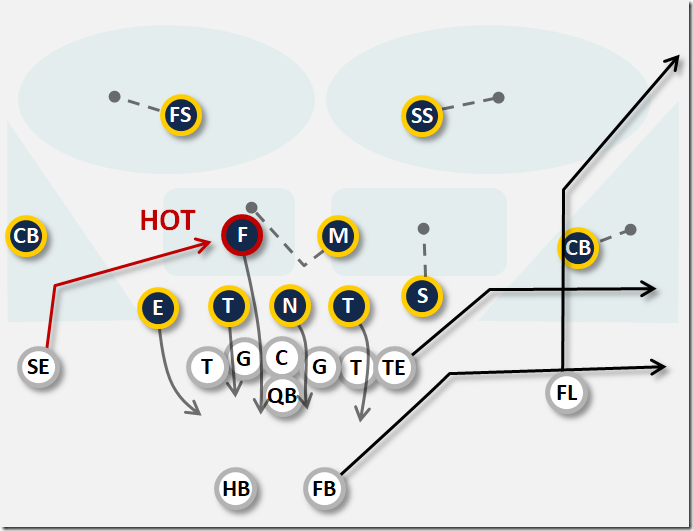
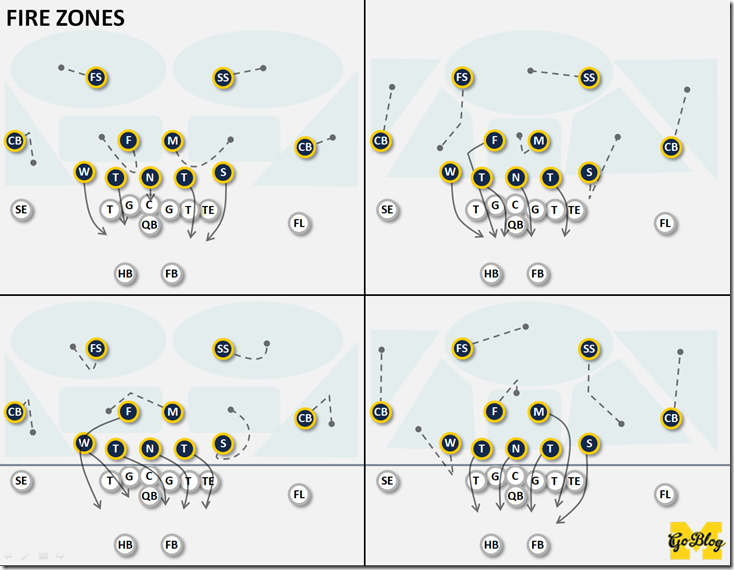
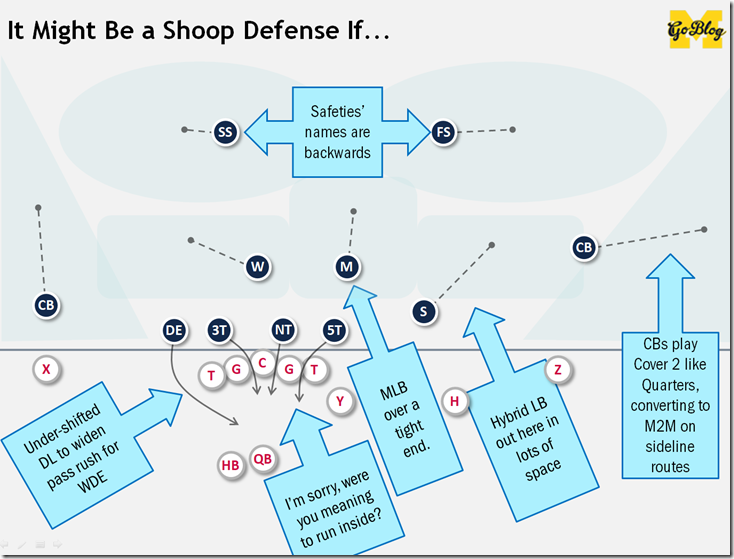
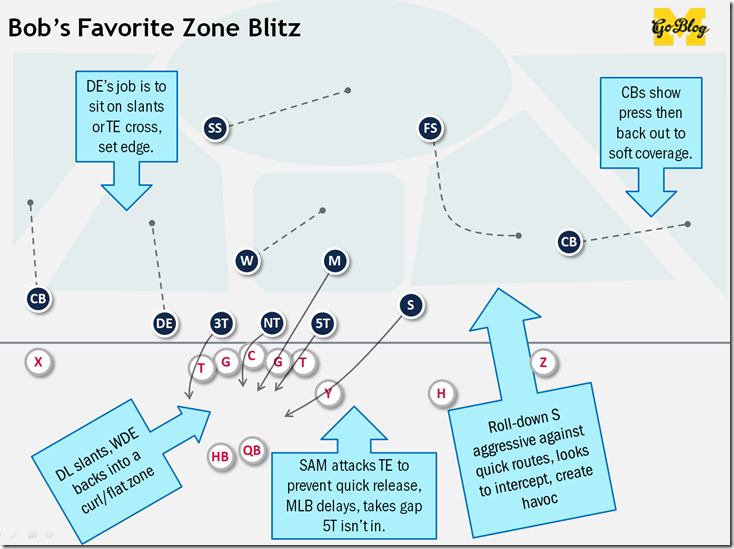

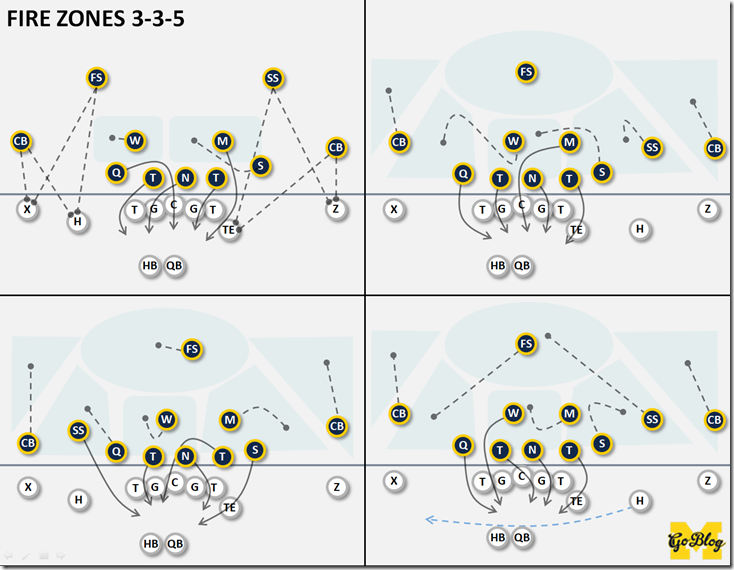
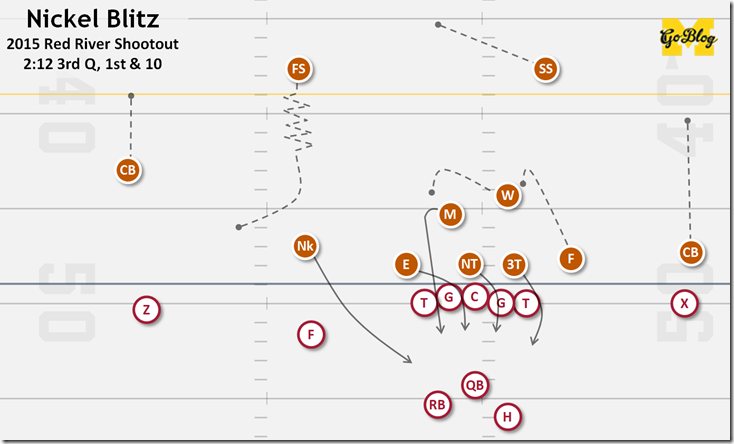
Comments